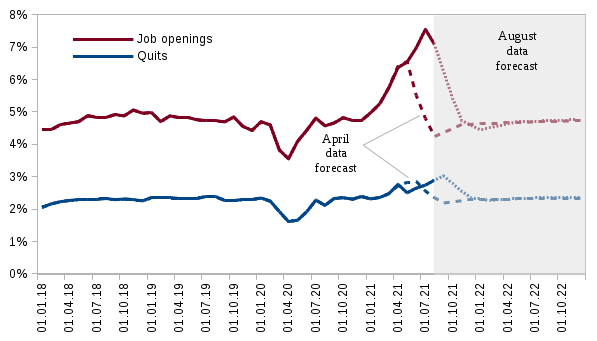The last time I looked at the data on quits and hires (see here) the outlook for the Great Resignation wave was to fade off in several months. Nevertheless, the most recent Bureau of Labor Statistics (BLS) report with preliminary figures for August 2021 shows that resignations continue their march.
Key Factors behind the Great Resignation
So what can explain the most recent dynamics of the labor market?
In a more recent piece on the topic I go with a very simple model for predicting quits on the US market (available here). The basic idea is that in order to quit an employee needs another job to be available. Moreover, the more the pool of these available new jobs, the more the chances are that a person chooses to switch workplaces.
So the major reasons for the Great Resignation phenomenon are most likely these:
- during the 2020 height of the COVID-19 pandemic lockdowns companies were actively laying out workers (remember those headlines about the record unemployment figures?) so the job openings were abnormally low;
- as the available jobs pool shrank, fewer job openings naturally led to an unusually low amount of quits;
- some additional factors like huge uncertainty about the future of the economy, uneven pandemic developments, lesser mobility, etc., also played an important role in tilting the level of quits down;
- after all the factors listed above stabilized or returned back to normal (well, as far as we can apply the word nowadays), job openings grew significantly in a way to compensate for the previous scarcity;
- subsequently quits also picked up to a higher than usual level – thus creating what is called the Great Resignation.
The Most Recent Resignations Data
The first chart below shows the time series for job openings and quits in the US economy as a percentage of the total employment. It is evident that my summer forecast based on the April 2021 data available at the time did not realize. So what differences were there, and what can they be explained by?
- Job openings continued to pick up for a much longer period than expected. The forecast main scenario was for the job openings to start to return back to their usual average of about 4.5% by September. However, job opportunities continued to grow until recently, only reversing the uninterrupted growth pattern in August. Several reasons most probably led to this outcome:
- a better than expected growth of the economy;
- less uncertainty about the pandemic future developments;
- the prospect for further federal spending support coming from the Biden administration.
- At the same time, the quits series behaved less straightforwardly. It could have been expected that resignations would continue to rise in line with the job openings data. However, there was a quite noticeable fall in resignations in May. After that, the line was moving more as expected following the job openings growth. The main reasons for this can be:
- the major part of the new job openings was filled by the unemployed;
- employers could be using some countermeasures to retain the employees they want on the job;
- for some workers, the uncertainty level still remained too high for setting sails for a new adventure.

The Forecast Update
In conclusion, as the chart shows, the updated outlook’s main scenario still expects the Great Resignation wave to be not that great and to subside relatively soon. Mirroring the previous forecast, the job openings increase, which is compensating for the drop in 2020, is expected to finally calm down. Consequently, the recent quits pick-up will also most likely go down until eventually stabilizing at the natural level of about 2% of current employment.

